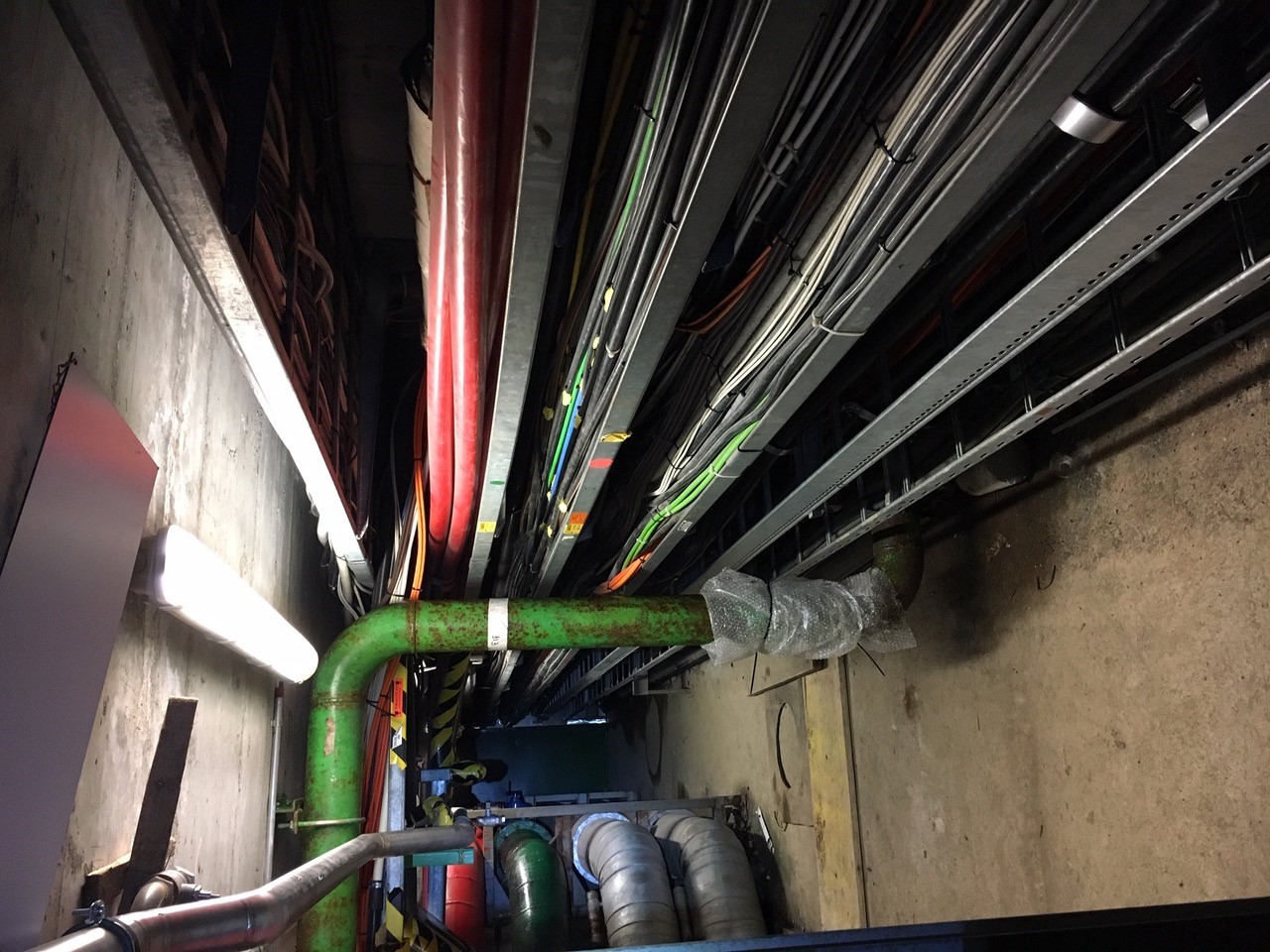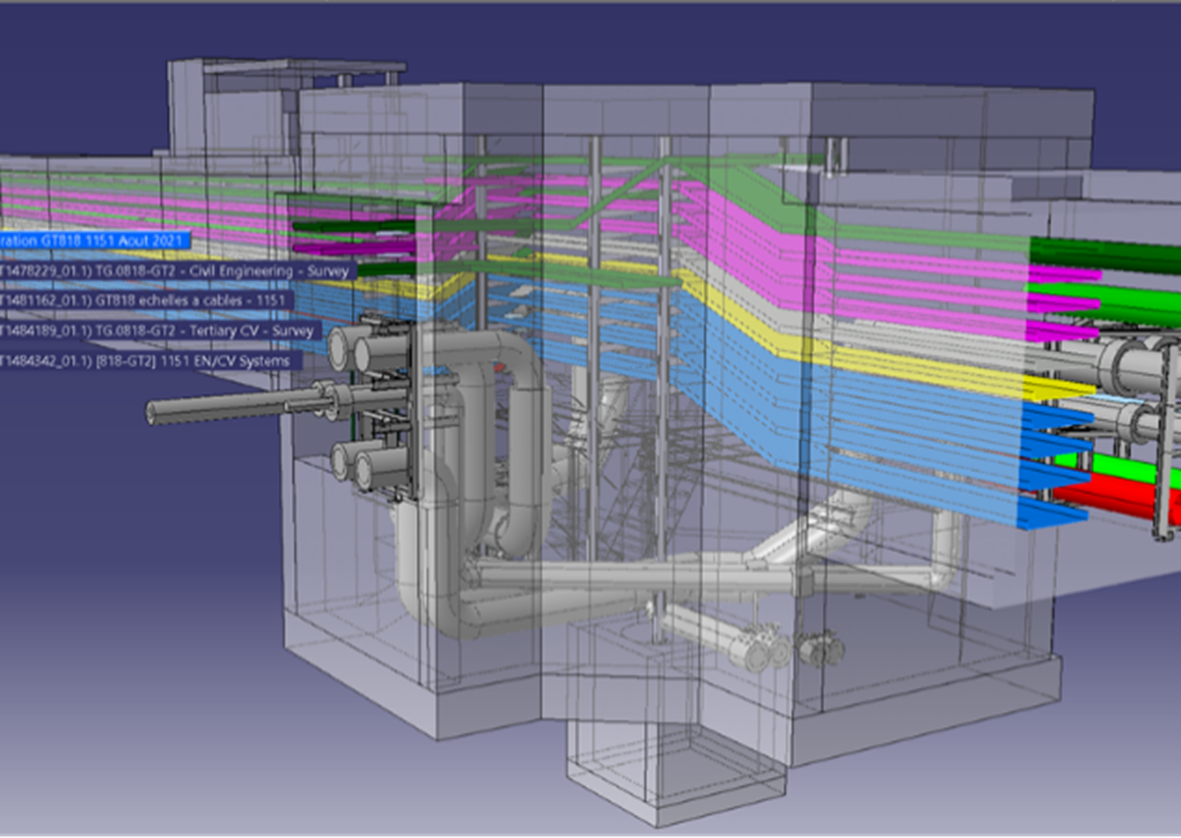Technical Galleries are used to distribute infrastructure services between different areas and buildings on the Meyrin and Prévessin sites and add up to a total distance of 14 kilometers. Examples of such galleries can be seen on Figure 1 below.
From Civil engineering works, heating network and drain systems to various water circuits (drinking, raw, firefighting, demineralized and chilled), they also house cables, optical fibers, access systems and gas pipes among others (see Figure 2 for an example).
As for the galleries, the installations and equipment located in them, date back to the mid-50s for the oldest ones. No systematic maintenance took place in the past years and in addition, a comprehensive inventory and identification of the services and their connection is not available. This led to a severely degraded situation, ranging from the bad conditions of the equipment (water infiltration, rust, corrosion, wear, clogged systems), to safety aspects (presence of asbestos, fire and ODH risks, accessibility and visibility), to an obsolete and non-adapted size of the equipment with respect to its use.

A serious breakdown of one of services in the galleries could affect the operation of one site, as services are not always available everywhere via redundant networks. All these reasons culminated in the launch of the Technical Galleries Consolidation Program, approved by the CERN Council in 2020. It shall remedy the existing issues and enable the refurbishment of the galleries’ conditions and their related infrastructure to the extent possible.
In addition to the general improvement of the situation, the Project shall also aim at evaluating the services according to the present needs of the sites with a look at probable future expansions, with respect to the Master Plan. Further improvements related to a better management of safety and environmental aspects (accessibility to galleries, presence of dangerous materials, and reduction of existing risks) shall also be part of the scope.
The EN Department leads this program with a strong involvement of the other technical departments. It bears many challenges, which will be listed and briefly commented in the following paragraphs. Collecting all the necessary documentation to define the current state of these facilities requires many inventories and on-site surveys as well as an update of various databases (Gesmar, GIS portal, …).
In order to better optimize the use of these galleries, a full integration and 3D modelling) will precede the re- 3 engineering phase. As usual, this process relies on accurate topographic scans that turned out to be difficult to carry out. As a matter of fact, aspects such as the Earth’s round shape must be considered, since some galleries are longer than one kilometer!
The renovation will comprise a lot of dismounting and reinstallation activities. Consequently, some minor service disruptions might occur in the vicinity of the buildings concerned. A logistics coordinated package will define all steps required, as well as the mitigation measures to implement, to guarantee the essential service’s continuity. That is also the reason why we decided to run two pilot projects in GT818 – see figure 3 (around building 860) and GT835 (around building 376). Their completion will certainly produce lessons to be learned for the benefit of future exercises.

Some key constraints will shape the Program schedule:
- Work size varies considerably between different galleries
- Hybrid topology: services to tertiary building or to machine facilities cannot be treated at the same time (operation period versus long shutdown)
- Service continuity must be guaranteed
- Resource availability in the groups involved
Safety aspects and decabling issues are also crosscutting themes dealt with in two specific coordination packages. Some synergies are being established with the Injector Decabling and North Area Consolidation Decabling projects. From a project management point of view, creating such synergies between departments and teams is challenging but also very motivating. To summarize, this interdepartmental program, led by the EN Department, was granted funding for a ten-year period (39 MCHF) under the Technical Infrastructure headline. It constitutes a good opportunity for a thorough reengineering and optimization process for CERN’s Technical galleries complex.
More details can be found in the CERN Bulletin
S. Evrard (EN-CV), I. Krautsztrung (EN-PAS)
Find the full EN Newsletter Issue #3 here!
